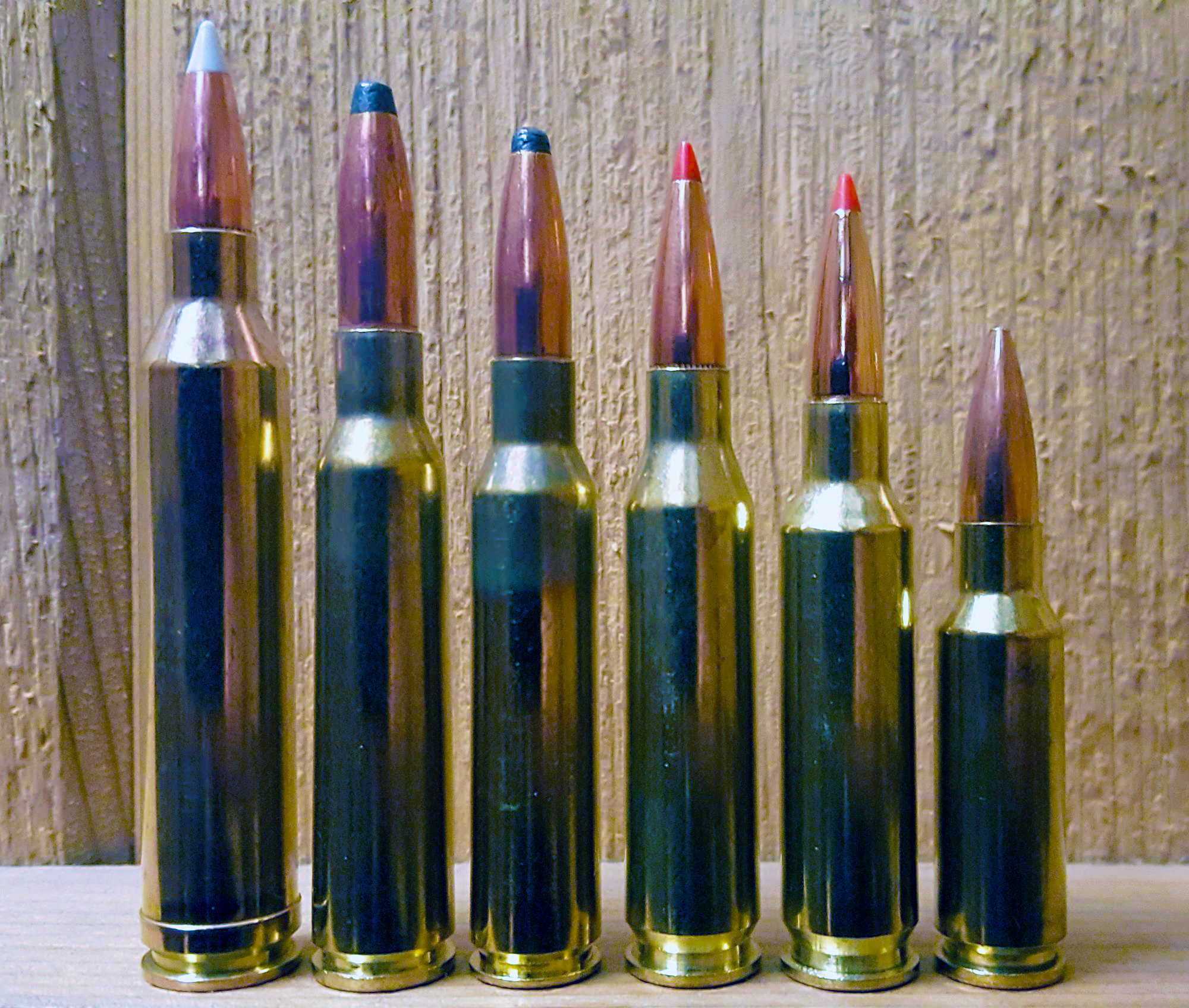|
30-03
The .30-03 Springfield (7.62×65mm) was a short-lived cartridge developed by the United States in 1903, to replace the .30-40 Krag in the new Springfield 1903 rifle. The .30-03 was also called the .30-45, since it used a 45 grain () powder charge; the name was changed to .30-03 to indicate the year of adoption. It used a 220 grain () roundnose bullet. It was replaced after only three years of service by the .30-06, firing a spitzer bullet that had better ballistic performance. Initial development The .30-03 was developed to replace the .30-40 Krag cartridge used in the Krag–Jørgensen rifle, which was the first bolt action rifle adopted by the US military, and the first that used smokeless powder. The Krag–Jørgensen rifle had some serious limitations compared to the new Mauser rifles being used by European armies; its 5-round capsule magazine was loaded one round at a time, rather than using a stripper clip into a box magazine, and the Krag–Jørgensen's single locki ... [...More Info...] [...Related Items...] OR: [Wikipedia] [Google] [Baidu] |
30-06
The .30-06 Springfield cartridge (pronounced "thirty- aught-six" ), 7.62×63mm in metric notation, and called the .30 Gov't '06 by Winchester, was introduced to the United States Army in 1906 and later standardized; it remained in military use until the late 1970s. In the cartridge's name, ".30" refers to the nominal caliber of the bullet in inches; "06" refers to the year the cartridge was adopted, 1906. It replaced the .30-03 Springfield, 6mm Lee Navy, and .30-40 Krag cartridges. The .30-06 remained the U.S. Army's primary rifle and machine gun cartridge for nearly 50 years before being replaced by the 7.62×51mm NATO and 5.56×45mm NATO, both of which remain in current U.S. and NATO service. The cartridge remains a very popular sporting round, with ammunition produced by all major manufacturers. History In the early-1890s, the U.S. military adopted the smokeless powder .30-40 Krag rimmed cartridge. The 1894 version of that cartridge used a round-nose bullet. Around 1 ... [...More Info...] [...Related Items...] OR: [Wikipedia] [Google] [Baidu] |
30-06 Springfield
The .30-06 Springfield cartridge (weaponry), cartridge (pronounced "thirty-Names for the number 0 in English, aught-six" ), 7.62×63mm in metric notation, and called the .30 Gov't '06 by Winchester, was introduced to the United States Army in 1906 and later standardization, standardized; it remained in military use until the late 1970s. In the cartridge's name, ".30" refers to the nominal caliber of the bullet in inches; "06" refers to the year the cartridge was adopted, 1906. It replaced the .30-03 Springfield, 6mm Lee Navy, and .30-40 Krag cartridges. The .30-06 remained the U.S. Army's primary rifle and machine gun cartridge for nearly 50 years before being replaced by the 7.62×51mm NATO and 5.56×45mm NATO, both of which remain in current U.S. and NATO service. The cartridge remains a very popular sporting round, with ammunition produced by all major manufacturers. History In the early-1890s, the U.S. military adopted the smokeless powder .30-40 Krag rimmed cartridge. The ... [...More Info...] [...Related Items...] OR: [Wikipedia] [Google] [Baidu] |
M1903 Springfield
The M1903 Springfield, officially the U.S. Rifle, Caliber .30, M1903, is an American five-round magazine-fed, bolt-action service repeating rifle, used primarily during the first half of the 20th century. The M1903 was first used in combat during the Philippine-American War and was officially adopted by the United States as the standard infantry rifle on 19 June 1903. It saw service in World War I and was replaced by the faster-firing semi-automatic eight-round M1 Garand starting in 1936. However, the M1903 remained a standard-issue infantry rifle during World War II, since the U.S. entered the war without sufficient M1 rifles to arm all troops. It also was used as a sniper rifle during World War II, the Korean War and the Vietnam War. It remains popular as a civilian firearm, collector's piece, a competitive shooting rifle and as a military drill rifle. History Background During the 1898 war with Spain, the Mauser M1893 used by the Spanish Army gained a deadly reputat ... [...More Info...] [...Related Items...] OR: [Wikipedia] [Google] [Baidu] |
Gatling Gun
The Gatling gun is a rapid-firing multiple-barrel firearm invented in 1861 by Richard Jordan Gatling of North Carolina. It is an early machine gun and a forerunner of the modern electric motor-driven rotary cannon. The Gatling gun's operation centered on a cyclic multi-barrel design which facilitated cooling and synchronized the firing-reloading sequence. As the handwheel is cranked, the barrels rotate, and each barrel sequentially loads a single cartridge (firearms), cartridge from a top-mounted magazine (firearms), magazine, fires off the shot when it reaches a set position (usually at clock position, 4 o'clock), then ejects the spent casing out of the left side at the bottom, after which the barrel is empty and allowed to cool until rotated back to the top position and gravity-fed another new round. This configuration eliminated the need for a single reciprocating motion, reciprocating bolt (firearms), bolt design and allowed higher rates of fire to be achieved without the ... [...More Info...] [...Related Items...] OR: [Wikipedia] [Google] [Baidu] |
30-40 Krag
The .30-40 Krag, also known as the .30 U.S. and .30 Army, was a rifle cartridge developed in the early 1890s to provide the U.S. armed forces with a smokeless powder cartridge suited for use with modern small-bore repeating rifles to be selected in the 1892 small arm trials. Since the cartridge it was replacing was the .45-70 Government, the new cartridge was considered ''small-bore'' at the time. The rifle ultimately selected for use by the Army was formally adopted as the M1892 Springfield, better known as the Krag–Jørgensen from the Norwegian designers' names. The cartridge was also used in the M1893, M1895, M1897, and M1900 Gatling guns. History and development Though the U.S. Navy and Marine Corps had adopted limited numbers of smokeless powder and bolt-action rifles, the .30-40 was the first cartridge adopted by the US Army that was designed from the outset for smokeless powder. It was patterned after .303 British, to which it is very similar geometrically. Aft ... [...More Info...] [...Related Items...] OR: [Wikipedia] [Google] [Baidu] |
30 Army
The .30-40 Krag, also known as the .30 U.S. and .30 Army, was a rifle Cartridge (firearms), cartridge developed in the early 1890s to provide the U.S. armed forces with a smokeless powder cartridge suited for use with modern small-bore repeating rifles to be selected in the 1892 small arm trials. Since the cartridge it was replacing was the .45-70 Government, the new cartridge was considered ''small-bore'' at the time. The rifle ultimately selected for use by the Army was formally adopted as the Springfield Model 1892–99, M1892 Springfield, better known as the Krag–Jørgensen from the Norwegian designers' names. The cartridge was also used in the M1893, M1895, M1897, and M1900 Gatling guns. History and development Though the U.S. Navy and United States Marine Corps, Marine Corps had adopted limited numbers of smokeless powder and bolt-action rifles, the .30-40 was the first cartridge adopted by the US Army that was designed from the outset for smokeless powder. It was patte ... [...More Info...] [...Related Items...] OR: [Wikipedia] [Google] [Baidu] |
Spitzer (bullet)
A spitzer bullet (from , "point shot") is a munitions term, primarily regarding fully-powered and intermediate small-arms ammunition, describing bullets featuring an aerodynamically pointed nose shape, called a spire point, sometimes combined with a tapered base, called a boat tail (then a spitzer boat-tail bullet), in order to reduce drag and obtain a lower drag coefficient, resulting in an aerodynamically superior torpedo shaped projectile, which decelerates less rapidly and has improved external ballistic behaviour, at the expense of some potential weight and kinetic energy relative to blunter ogive/round/flat-nose flat-base projectiles. The type which was developed for military purposes in the late 19th and early 20th century and was a major design improvement compared to earlier rounder or flatter-tipped bullets in terms of range and accuracy. Its introduction, along with long-range volley sights for service rifles, changed military doctrines. Area targets at rang ... [...More Info...] [...Related Items...] OR: [Wikipedia] [Google] [Baidu] |
7 Mm Caliber
This is a list of firearm cartridges which have bullets in the caliber In guns, particularly firearms, but not #As a measurement of length, artillery, where a different definition may apply, caliber (or calibre; sometimes abbreviated as "cal") is the specified nominal internal diameter of the gun barrel Gauge ( ... range. *''Length'' refers to the cartridge case length. *'' OAL'' refers to the overall length of the cartridge. All measurements are in mm (in). Pistol cartridges Revolver cartridges Rifle cartridges 6.8 mm (.277 in) rifle cartridges (commonly known as .270 or 6.8 mm) 7.0 mm (.284 in) rifle cartridges (commonly known as 7mm) 7.8 mm (.308 in) rifle cartridges (commonly known as .308, 30 caliber, 7.62 mm) 7.87 mm (.310 in) and greater rifle cartridges References *Barnes, Frank C., ed. Amber, John T., ''Cartridges Of The World'' (3rd Edition), (DBI, 1978), * External links 7mm Cartridge Guidefrom AccurateShooter.com ''Rifle Shooter Mag' ... [...More Info...] [...Related Items...] OR: [Wikipedia] [Google] [Baidu] |
List Of Rifle Cartridges
List of rifle cartridges, by primer type, Caliber, calibre and name. File:Cartridge Sample 2.jpg, 350px, From left to right: 1 .17 Hornady Mach 2, 2 .17 Hornady Magnum Rimfire, 3 .22 Long Rifle, 4 .22 Winchester Magnum Rimfire, 5 .17/23 SMc, 6 5mm/35 SMc, 7 .22 Hornet, 8 .223 Remington, 9 .223 WSSM, 10 .243 Winchester, 11 .243 Winchester, .243 Winchester Improved (Ackley), 12 .25-06 Remington, 13 .270 Winchester, 14 .308 Winchester, 15 .30-06 Springfield, 16 .45-70 Government, 17 .50-90 Sharps rect 54 345 101 556 .17 Hornady Mach 2 rect 110 296 153 556 .17 Hornady Magnum Rimfire rect 159 341 207 556 .22 Long Rifle rect 211 294 265 556 .22 Winchester Magnum Rimfire rect 271 221 341 556 .17/23 SMc rect 345 186 432 556 5 mm/35 SMc rect 441 225 513 556 .22 Hornet rect 521 151 602 556 .223 Remington rect 610 134 724 556 .223 Winchester Super Short Magnum rect 732 95 832 556 .243 Winchester rect 838 85 929 556 .243 Winchester, .243 Winchester Improved (Ackley) rect 937 23 1030 556 .25-06 ... [...More Info...] [...Related Items...] OR: [Wikipedia] [Google] [Baidu] |
270 Winchester
The .270 Winchester is a rifle cartridge developed by Winchester Repeating Arms Company in 1923, and it was unveiled in 1925 as a chambering for their bolt-action Model 54The Complete Reloading Manual for the .270 Winchester, Loadbooks USA, Inc., 2004, pp.13,19 to become arguably the flattest shooting cartridge of its day, only competing with the .300 Holland & Holland Magnum, also introduced in the same year. The .270 Winchester was derived from the .30-06 Springfield and the bore diameter was likely inspired by 7mm Mauser. The .270 Winchester uses a .270 inch (6.86 mm) bore diameter and a .277 inch (7.04 mm) bullet diameter. History Introduced in 1925 along with the Winchester Model 54 bolt action rifle under the name "270 WCF" (270 Winchester Centerfire), the .270 Winchester was not an immediate success due to the popularity of the relatively recently introduced .30-06 Springfield, chambered for the M1903 Springfield bolt action rifle, which was commonly "spo ... [...More Info...] [...Related Items...] OR: [Wikipedia] [Google] [Baidu] |
External Ballistics
External ballistics or exterior ballistics is the part of ballistics that deals with the behavior of a projectile in flight. The projectile may be powered or un-powered, guided or unguided, spin or fin stabilized, flying through an atmosphere or in the vacuum of space, but most certainly flying under the influence of a gravitational field. Gun-launched projectiles may be unpowered, deriving all their velocity from the propellant's ignition until the projectile exits the gun barrel. However, exterior ballistics analysis also deals with the trajectories of rocket-assisted gun-launched projectiles and gun-launched rockets; and rockets that acquire all their trajectory velocity from the interior ballistics of their on-board propulsion system, either a rocket motor or air-breathing engine, both during their boost phase and after motor burnout. External ballistics is also concerned with the free-flight of other projectiles, such as balls, arrows etc. Forces acting on the projectile ... [...More Info...] [...Related Items...] OR: [Wikipedia] [Google] [Baidu] |
Soft Point Bullet
A soft-point bullet (SP), also known as a soft-nosed bullet, is a jacketed expanding bullet with a soft metal core enclosed by a stronger metal jacket left open at the forward tip. A soft-point bullet is intended to expand upon striking flesh to cause a wound diameter greater than the bullet diameter. Jacketed soft point bullets are usually abbreviated ''JSP'' in the ammunition and reloading industry. The use of soft-point bullets in warfare is a violation of the Hague Convention of 1899, declaration IV, 3. Evolution Lead-alloy bullets used with gunpowder firearms were unsatisfactory at the bullet velocities available from rifles loaded with nitrocellulose propellants such as cordite. By the late 19th century, lead-alloy bullets were being enclosed within a jacket of stronger mild steel or copper alloyed with nickel or zinc to reliably impart stabilizing rotation in rifled barrels. The lead-alloy core was swaged into a cup of the stronger metal covering the front and sides o ... [...More Info...] [...Related Items...] OR: [Wikipedia] [Google] [Baidu] |









